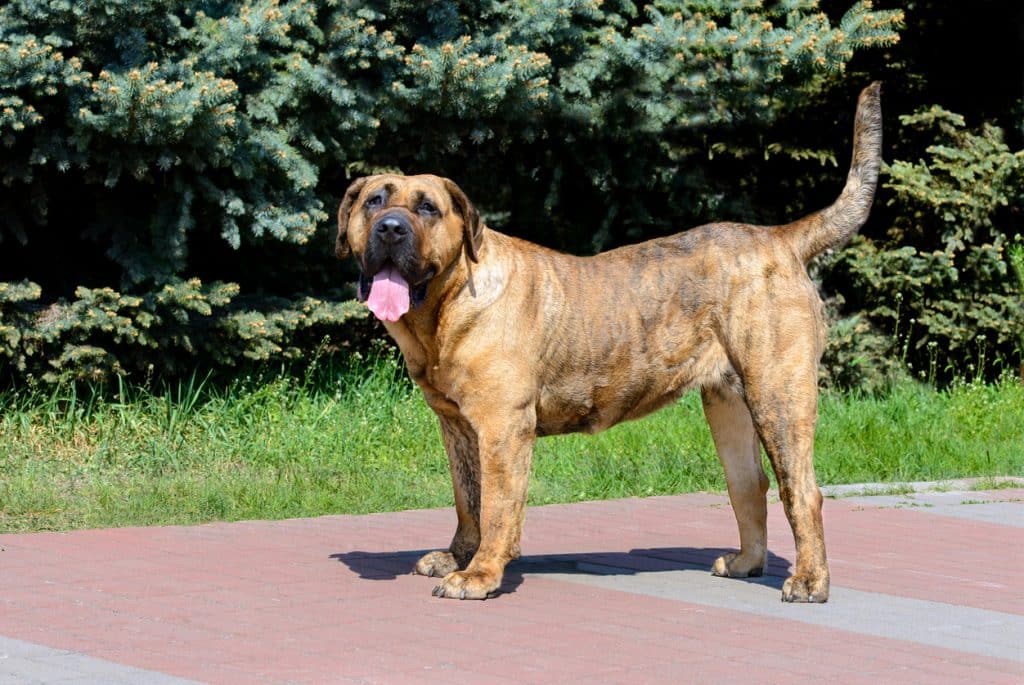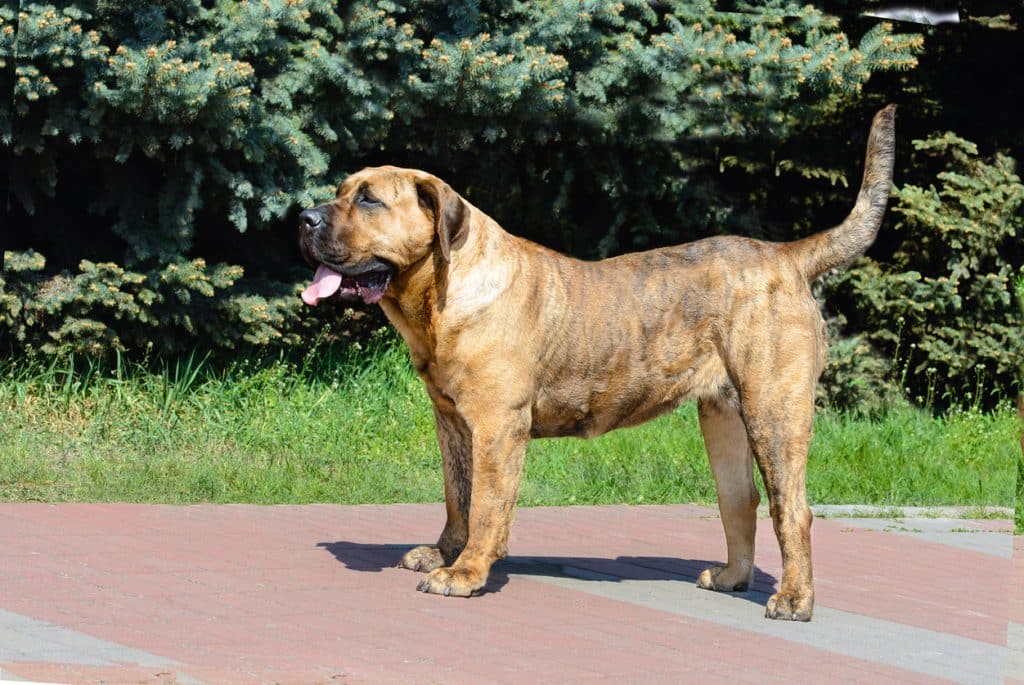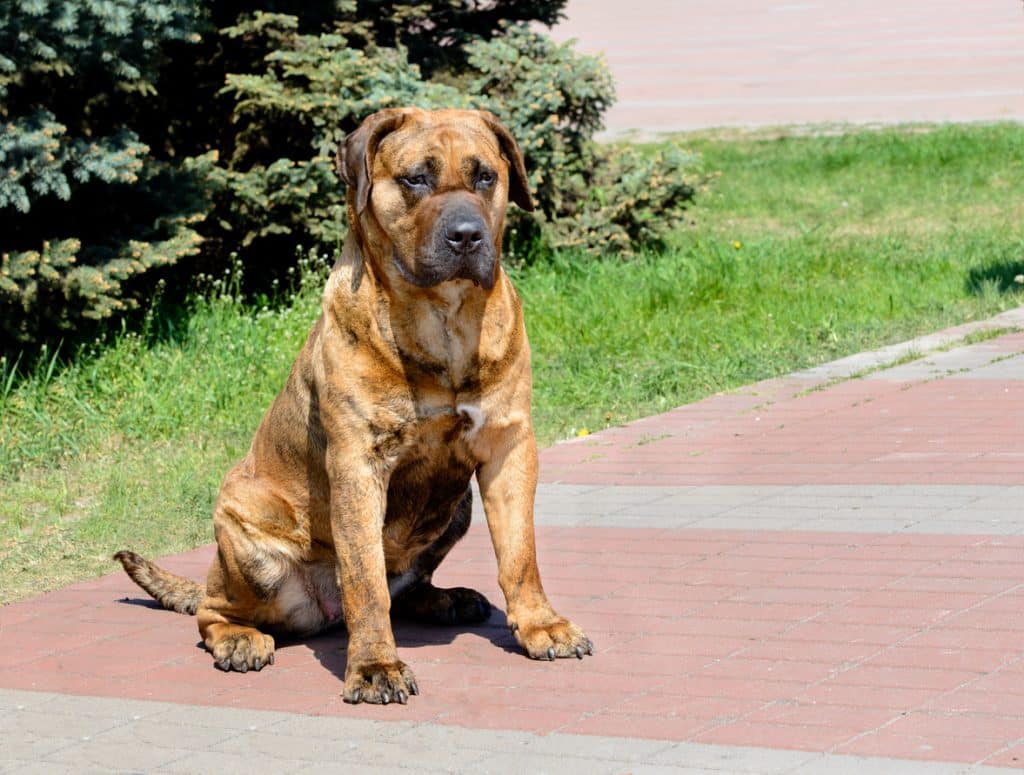
A relatively rare breed, Canary Mastiffs—also known as Presa Canarios or Canario Mastiffs—are named after their Canary Island heritage. While these giant canines share a name with their Mastiff cousins, their attributes can differ. For instance, the English variety is more laid-back, while Bullmastiffs enjoy more physical activity.
Presa Canarios are often confused with Cane Corsos, as their appearance and activity levels are similar. But Presas are not the same as Cane Corsos: look more closely, and you’ll see that Cane Corso’s are taller and not so stocky.
Originally bred as guard dogs, Canary Mastiffs these days are happy to play and laze in family homes. However, new owners should recognize their main personality traits: while loyal and smart, they can be stubborn and aggressive. As such, Canary Mastiffs require early training and socialization to become good family members, especially if children and other pets are around.
Key
- Low
- Medium
- High
- Origin: Canary Islands, Spain
- Size:
- Size: 22–26 inches at the withers
- Weight (Male): 100–130 lbs
- Weight (Female): 88–120 lbs
- Activity level:
- Barking/howling level:
- Good with cats:
- Shedding:
- Hair type: Short
- Grooming level:
- Training level:
- Drooling level:
Appearance
Mastiffs in general are known for their size, so how big do Canary Mastiffs get? While not as tall as some of its Mastiff cousins (such as the English Mastiff), this breed still grows relatively large.
Canary Mastiffs are well-proportioned and have a muscular, stocky appearance; perfect for guarding duties. According to the world’s largest canine organization, Federation Cynologique Internationale (AISBL), Canary Mastiffs have a longer body length compared to their height at the withers, with this trait more evident among females.
This breed’s coat comes in black, brown, fawn, or brindle colorings, with white markings. One consistent element among Canary Mastiffs is the distinctive black shading around their nose and muzzle.
When Canary Mastiffs are small, “They mostly resemble a large Labrador retriever,” reveals Elijah Prada, breeder at SoCalPresa, a Canary Mastiff breeder with locations in Texas and California. At about six months, the dog’s face and body will start becoming more Presa-like. They reach full growth by 20-24 months, Prada says, and you can tell when a dog is entering its senior years as “their black mask [starts] turning white.”
Prada explains that, for the average owner, it’s not so easy to tell whether a particular Canary Mastiff is purebred or mixed. However, if the canine in question is obviously missing one or more of their breed’s “characteristic” physical traits (such as the black muzzle), it’s usually a sign that it’s mixed. If you’re unsure, check with a breeder. “A connoisseur of this breed can usually understand quickly if it is a pure breed or a mixed dog,” he notes.
History
Canary Mastiffs originate from Spain’s Canary Islands. However, as the Continental Kennel Club reveals, the islands were named after the dogs rather than the other way around.
It’s thought that Bardino Majorero dogs were brought to the islands by settlers around 1000 BC. But travelers who came to the islands in the 18th Century brought with them dogs of other breeds (including English Mastiffs), who bred with Bardino Majorero to create Canary Mastiffs.
Initially, the breed was used for guarding. But, as Texas West Animal Health explains, many Canary Mastiffs in the early 1900s were bred for dog fighting. When a fighting ban came into effect in 1940, their numbers went into decline – and by 1960, Canary Mastiffs were close to extinction.
They were revived when anthropologist Dr Carl Semencic took an interest in the breed and spread awareness about it. Although introduced to US soil in the 1980s, the American Kennel Club still does not officially “recognize” the Canary Mastiff breed. While you can legally own a Canary Mastiff in many areas of the USA, some cities have ownership and possession bans or restrictions in place. These include municipalities in:
- Alabama
- Colorado
- Florida
- Indiana
- Iowa
- Kansas
- Louisiana
- Maine
- Massachusetts
- Nebraska
- New York
- Ohio
- Oregon
- Washington
- West Virginia
- Wisconsin
Internationally, the breed is banned or restricted in Australia, New Zealand, Singapore, Bermuda, Malaysia, and St. Kitts & Nevis.

Personality, Lifestyle & Training Tips
A Presa Canario’s personality is somewhat mixed! As a guardian breed, “they will always have protective tendencies when it comes to what they perceive as their property [such as their house and yard] and their pack [members of the immediate family],” explains Sarah Rosenblum, executive director at Bullpen Rescue, a giant breed rescue in Norwood, Georgia.
But they also have a softer side. “With their people, Presas are devoted, obedient, and gentle,” continues Rosenblum. “They are generally quite independent and intelligent, but can be stubborn and strong-willed.”
Due to their headstrong nature, a Presa is not a good option for first-time owners. Those who adopt this breed should fully understand their new addition and adapt their lifestyle accordingly. “For example, owning a Presa means visitors can no longer walk into your home unannounced,” reveals Rosenblum. “Your dog cannot distinguish whether that person is an ax murderer or your neighbor. It will instinctively do what it was bred to: protect you and your family.”
Being on guard means Presa Canarios don’t always mix well with other people or dogs. “Presas are highly suspicious of new or unfamiliar people and animals and will usually act boldly and quickly to protect against it,” shares Rosenblum.
However, Presa Canarios can still be a good family dog. “We’ve successfully placed many Presas into homes with other pets of all species,” says Rosenblum. “The key to successful interactions between Presas and existing dogs in the home is [usually] dictated by the owner’s ability to follow decompression and slow integration protocols.”
Canary Mastiffs’ daily activities
Today, Canary Mastiffs don’t have to engage in guarding activities to feel fulfilled. “Most Presas don’t need a job to be happy,” says Rosenblum. “They are more than content to live in a home that provides a moderate amount of mental stimulation and physical activity every day.”
Canary Mastiffs are happy with a combination of entertaining themselves (think chew toys and bones) and playing with others. “Some also enjoy task-based toys and games that provide mental stimulation as well as exercise,” Rosenblum adds.
Although these dogs love being around their people, Rosenblum reveals they’re OK alone for periods. “They aren’t particularly prone to destructive behavior when left alone,” she states. “That said, we always strongly recommend crating dogs when left unattended until you are confident they can safely free-roam in your absence.”
Training Canary Mastiffs for success
Considering their stubborn nature, are Canary Mastiffs difficult to train? It largely depends on the person teaching them, says Ali Smith, professional dog trainer at Rebarkable dog training in Maryland. However, more generally, “the Presa is not necessarily considered a people pleaser, which would mean they’re not easy to train compared to, say, a Labrador.”
Training a Presa requires plenty of patience and understanding. With a strong independent streak, they’re often keen to complete their own tasks, and “problems arise when what your Presa considers to be their goal is not the same as yours!” To help avoid this, Smith says the key is “to make yourself the most rewarding thing in their world.”
Working dogs usually require a bit more time and effort with initial training and subsequent reinforcement. But you don’t need to go overboard, notes Smith. “10–20 minutes a day would suffice to create a wonderful companion,” she says.
Alongside behavior and socialization training, Smith reveals Canary Mastiffs can be trained in some working tasks. For instance, “they can herd, livestock guard, and property guard with relative ease to a practiced handler.”
It’s essential to train and socialize this breed from an early age. Without the correct skills under their collars, the biggest risk (especially considering their size) is a Presa’s “potential to redirect their guarding past into a reactivity towards people, dogs, or livestock,” explains Smith.
As active dogs, rest is equally important, but Canary Mastiffs don’t need much encouragement. “[They] tend to be a little lazy at heart and will make phenomenal sofa ornaments!” Smith shares.

Grooming Needs
With a single coat and short hair, a Presa’s grooming needs are relatively straightforward. Plus, unlike other breeds, they don’t really have a shedding “schedule”, notes Stuart Simons, dog groomer and director of The Groomers Spotlight in London, UK. That said, “they may drop more coat depending on daylight hours, so watch for the summer/winter time changes.”
Because of their size, grooming at home can be tricky. “Professional grooming would be best for these guys, unless you want to get soaked!” shares Simons. But you can still provide lighter maintenance between grooms. Use a curry comb to brush out dead hair, says Simons, adding that they can be bathed as often as you wish. However, given their coat and height off the floor, they’ll likely just need “a good wipe of their feet when they come inside.”
Kim Kier, dog groomer and founder of Little Barks Grooming, in Columbia, South Carolina, says that, due to their short hair, Canary Mastiffs’ “skin and coat require 40% more oil.” As such, she recommends applying a high-quality oil to their coat three to five times a week. “My favorites are emu, argan, avocado, and camellia,” Kier reveals. Apply a dime-sized amount of oil into your hands, rub over the coat, then brush through with a Boars brush.
Remember to give smaller areas some attention! “Cleaning and checking the ears weekly will spare your Canario from ear infection,” states Kier. “If the ear is tender or has an odor, contact your veterinarian.”
As Canary Mastiffs are active, it’s important to keep nails short. “I recommend trimming and filing every 2 to 4 weeks,” Kier says.
Health
Presa’s are considered relatively healthy, says Dr. Sarah Gorman at Small Door Veterinary, a veterinary chain in the U.S. However, “like all breeds, they are susceptible to certain health issues,” she notes. “Responsible breeding practices can help minimize genetic predispositions to some of these conditions.” Some common concerns include:
Hip dysplasia. As a large breed, Presas are prone to this genetic condition, notes Gorman. “Treatment can be expensive, often requiring surgery or long-term management,” she adds, although maintaining a healthy weight can reduce risk.
Elbow dysplasia. Gorman explains this is mainly genetic, although responsible breeding and healthy weight maintenance can lower their risk of developing the concern.
Hypothyroidism. “For any larger breed of dog, this is more common as they age,” Gorman reveals. “Signs include weight gain, skin issues, panting, weakness, and neurologic signs. It’s easy to diagnose but requires lifelong treatment.”
Entropion (inward turning of the eyelid). Presas are more prone to this genetic issue “due to their facial structure,” says Gorman. “Surgical correction is required and can be moderately expensive.”
Gastric Torsion. This is a potentially life-threatening concern that requires emergency surgery. “Larger, deep-chested breeds like Presas are more prone,” shares Gorman. “Feeding multiple small meals a day and avoiding exercise straight after meals can help reduce risk.”
Demodectic Mange. Any breed can be affected, and the concern is “often related to a weakened immune system,” shares Gorman. Treatment costs can be moderate, but maintaining good overall health and hygiene can lower the risk of development.
Canary Mastiff diet
Owners should be mindful of what they feed their Canary Mastiff. “A high-quality dog food that’s formulated for large breeds is generally recommended,” Gorman shares. “Protein content should be appropriate for their activity level, typically around 18-22% protein.”
Ultimately, “their dietary needs may vary based on age, activity level, and individual metabolism,” notes Gorman. As such, she advises consulting a vet to receive personalized dietary recommendations for your pooch.
Alternative Dog Breeds to Consider
Perhaps Presas aren’t quite right for you, but you’d like a dog that is still large in size, protective in nature, and known for its smart and loyal tendencies. Why not consider one of these breeds?
- Cane Corso
- Dogue de Bordeaux
- Dogo Argentino
- English Mastiff
- Great Dane
- Boerboel
- Tibetan Mastiff

Where to Find Canary Mastiffs
Have lots of playful energy and the time to visit the park daily, but also know when to enforce boundaries? A Canary Mastiff could be for you. But where can potential owners adopt this breed?
The Presa Canario Club of America is a breeder association offering lots of information about these dogs. Meanwhile, Good Dog and the American Kennel Club’s Marketplace have listings of puppies from breeders country-wide. As for how much it costs to buy a Canary Mastiff puppy, prices range from $2,500–$6,500+.
You might want to consider a rescue Canary Mastiff, especially as, in many cases, they will already have received behavior and socialization training. Some rescue centers that re-home this breed include:
Sources
- Alain, J.L. (2023). Restricted or banned dog breeds in each State. https://www.thepetzealot.com/2023/04/restricted-or-banned-dog-breeds-in-each.html?m=1
- Boogie the Pug. (2022). A list of banned breeds by country. https://boogiethepug.com/banned-breeds/
- Continental Kennel Club. (n.d.). Meet the Perro De Presa Canario. https://ckcusa.com/breeds/perro-de-presa-canario/
- Federation Cynologique Internationale. (2023). Presa Canario. https://www.fci.be/Nomenclature/Standards/346g02-en.pdf
- Gorman, S. (2023). Personal interview.
- Kier, K. (2023). Personal interview.
- Prada, E. (2023). Personal interview.
- Rosenblum, S. (2023). Personal interview.
- Simons, S. (2023). Personal interview.
- Smith, A. (2023). Personal interview.
- Texas West Animal Health. (n.d.). Perro De Presa Canario. https://www.texaswestveterinarian.com/perro-de-presa-canario/